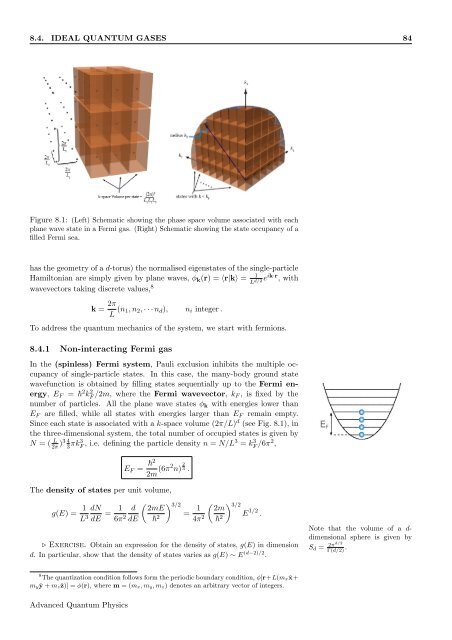Identical Particles - Theory of Condensed Matter
Identical Particles - Theory of Condensed Matter
Identical Particles - Theory of Condensed Matter
Create successful ePaper yourself
Turn your PDF publications into a flip-book with our unique Google optimized e-Paper software.
8.4. IDEAL QUANTUM GASES 84<br />
Figure 8.1: (Left) Schematic showing the phase space volume associated with each<br />
plane wave state in a Fermi gas. (Right) Schematic showing the state occupancy <strong>of</strong> a<br />
filled Fermi sea.<br />
has the geometry <strong>of</strong> a d-torus) the normalised eigenstates <strong>of</strong> the single-particle<br />
Hamiltonian are simply given by plane waves, φk(r) =〈r|k〉 = 1<br />
L d/2 e ik·r , with<br />
wavevectors taking discrete values, 8<br />
k = 2π<br />
L (n1,n2, · · · nd), ni integer .<br />
To address the quantum mechanics <strong>of</strong> the system, we start with fermions.<br />
8.4.1 Non-interacting Fermi gas<br />
In the (spinless) Fermi system, Pauli exclusion inhibits the multiple occupancy<br />
<strong>of</strong> single-particle states. In this case, the many-body ground state<br />
wavefunction is obtained by filling states sequentially up to the Fermi energy,<br />
EF = 2 k 2 F /2m, where the Fermi wavevector, kF , is fixed by the<br />
number <strong>of</strong> particles. All the plane wave states φk with energies lower than<br />
EF are filled, while all states with energies larger than EF remain empty.<br />
Since each state is associated with a k-space volume (2π/L) d (see Fig. 8.1), in<br />
the three-dimensional system, the total number <strong>of</strong> occupied states is given by<br />
N =( L 4<br />
2π<br />
)3<br />
3πk3 F , i.e. defining the particle density n = N/L3 = k3 F /6π2 ,<br />
EF = 2<br />
2m (6π2 n) 2<br />
3 .<br />
The density <strong>of</strong> states per unit volume,<br />
g(E) = 1<br />
L3 dN<br />
dE<br />
1<br />
=<br />
6π2 d<br />
dE<br />
2mE<br />
2<br />
3/2<br />
= 1<br />
4π 2<br />
<br />
2m<br />
2 3/2 E 1/2 .<br />
⊲ Exercise. Obtain an expression for the density <strong>of</strong> states, g(E) in dimension<br />
d. In particular, show that the density <strong>of</strong> states varies as g(E) ∼ E (d−2)/2 .<br />
8 The quantization condition follows form the periodic boundary condition, φ[r+L(mxˆx+<br />
my ˆy + mzˆz)] = φ(r), where m =(mx,my,mz) denotes an arbitrary vector <strong>of</strong> integers.<br />
Advanced Quantum Physics<br />
Note that the volume <strong>of</strong> a ddimensional<br />
sphere is given by<br />
Sd = 2πd/2<br />
Γ(d/2) .

















